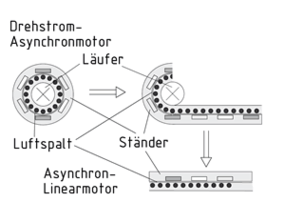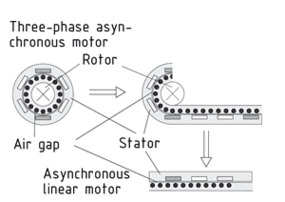
一种定义
四种语言
0,1,2
- 德國
- 英語
- 中國
- 西班牙語
直线电动机

与传统的旋转电动机不同,直线电动机传送线性运动而非旋转运动。应用领域包括机床、定位系统或铁道系统驱动的移动和运输过程,例如磁悬浮列车或过山车。
直线电动机的基本设计类似于同步或异步旋转电动机的操作原理。但是要使用移动式磁场而不是旋转磁场来激励电动机。
电感梳(相当于旋转电动机定子)的移动式磁场诱导反应轨(相当于传统电动机的电枢)产生电压,这将在移动式磁场的方向产生作用力。如果反应轨被固定,电感梳就会偏离移动式磁场。
直线电动机的一个优点是不需要齿轮,从而降低了磨损和功率损耗。其设计简单,运行可靠,维护成本低。但缺点是输出功率、效率和推力较低。此外,直线电动机需要进行细致改良以适应预期用途。扩展次级组件也需要更多材料。
异步旋转电机与异步直线电动机
Linearmotor

Linearmotoren erzeugen im Gegensatz zu konventionellen, rotierenden Motoren keine umlaufende, sondern eine geradlinige Bewegung. Anwendungsgebiete sind folglich Schiebe- und Transportvorgänge. Dies können zum Beispiel Werkzeugmaschinen, Positioniersysteme oder auch Bahnantriebe wie der Transrapid oder Achterbahnen sein.
Der Aufbau eines Linearmotors entspricht den Wirkungsprinzipien von umlaufenden Asynchron- beziehungsweise Synchronmotoren. Statt eines magnetischen Drehfeldes wird ein magnetisches Wanderfeld zur Erregung verwendet.
Das magnetische Wanderfeld des Induktorkamms (entspricht dem Ständer eines umlaufenden Motors) induziert eine Spannung in der Reaktionsschiene, dem Pendant zum Anker bei herkömmlichen Motoren, woraufhin eine Kraft in Richtung des Wanderfeldes ausgeübt wird. Wird die Reaktionsschiene ortsfest ausgelegt, so bewegt sich der Induktorkamm entgegen dem Wanderfeld.
Vorteile von Linearmotoren sind der Wegfall von Getrieben und - damit einhergehend - der verringerte Verschleiß sowie die Leistungsverluste. Dank eines einfachen Aufbaus sind Linearmotoren zudem betriebssicher und wartungsarm. Nachteilig sind der geringere Leistungsfaktor, der verminderte Wirkungsgrad sowie die geringere Schubkraft. Außerdem müssen Linearmotoren stets genau an ihren Einsatzzweck angepasst werden. Der gestreckte Sekundärteil verlangt zudem ein erhöhtes Materialaufkommen.
Linear motor

In contrast to conventional, rotating motors, linear motors deliver linear rather than rotatory movement. Areas of application include moving and transport processes, such as those facilitated by machine tools, positioning systems or railway drives such as the Transrapid or roller coasters.
The basic Design of a linear motor corresponds to the principles of operation of rotary asynchronous or synchronous motors. However, a travelling magnetic field is used for excitation instead of a rotary magnetic field.
The travelling magnetic field of the inductor comb (corresponds to the stator of a rotary motor) induces a voltage in the reaction rail (counterpart to the armature in conventional motors), which causes a Force to be applied in the direction of the travelling field. If the reaction rail is fixed in place, the inductor comb moves away from the travelling field.
One advantage of linear motors is that they dispense with the need for gears, which reduces both Wear and Power losses. Their simple design means that linear motors are also operationally reliable and low-maintenance. Disadvantages are the lower power output, reduced efficiency and the lower thrust force. Additionally, linear motors always have to be carefully modified to suit the intended use. The extended secondary component also requires more material.
Motor lineal

En contraste con los motores rotativos convencionales, los motores lineales suministran movimiento lineal en lugar de rotativo. Las áreas de aplicación incluyen los procesos de movimiento y transporte, como los facilitados por las herramientas de máquinas, los sistemas de posicionamiento o los impulsos de rieles como el Transrapid o las montañas rusas.
El diseño básico de un motor lineal corresponde a los principios de operación de motores asíncronos y síncronos rotativos. Sin embargo, se usa un campo magnético viajero para la excitación, en lugar de un campo magnético rotativo.
El campo magnético viajero del panal de inducción (corresponde al estator de un motor rotativo) induce un voltaje en el riel de reacción (contraparte de la armadura de motores convencionales), lo que hace que se aplique una fuerza en la dirección del campo viajero. Si el riel de reacción se fija en su lugar, el panal inductor se mueve lejos del campo viajero.
Una ventaja de los motores lineales es que dispensan mediante engranes, lo que reduce tanto el desgaste como las pérdidas de energía. Su diseño simple significa que los motores lineales también son operativamente confiables y de bajo mantenimiento. Las desventajas son una baja energía de salida, eficiencia reducida y baja fuerza de empuje. Adicionalmente, los motores lineales siempre deben ser modificados cuidadosamente para ajustarse al uso propuesto. El componente secundario extendido también requiere más material.
Desde una máquina asíncrona rotativa a un motor lineal asíncrono
